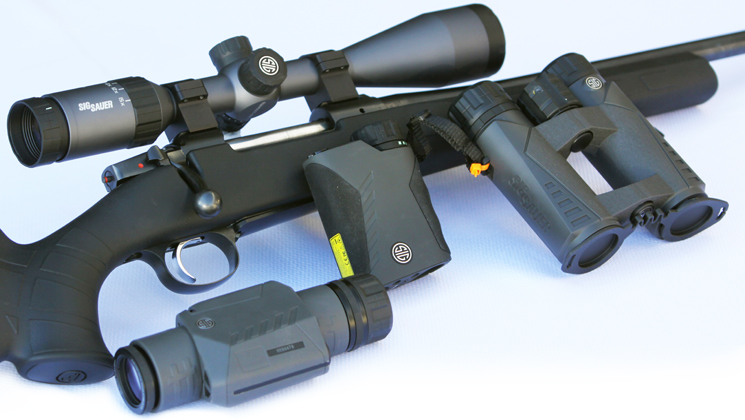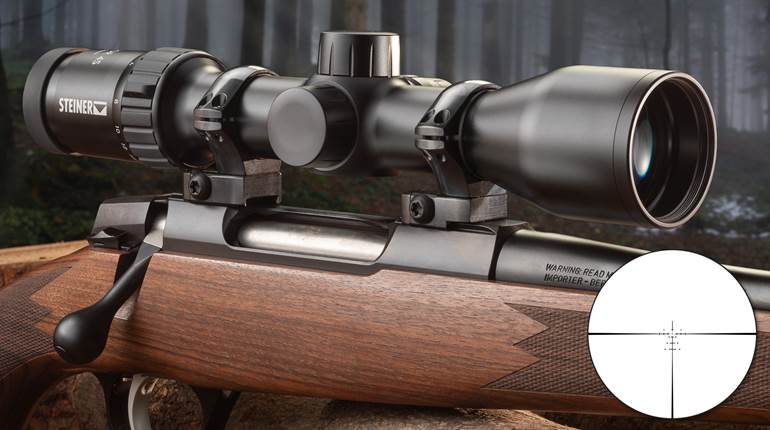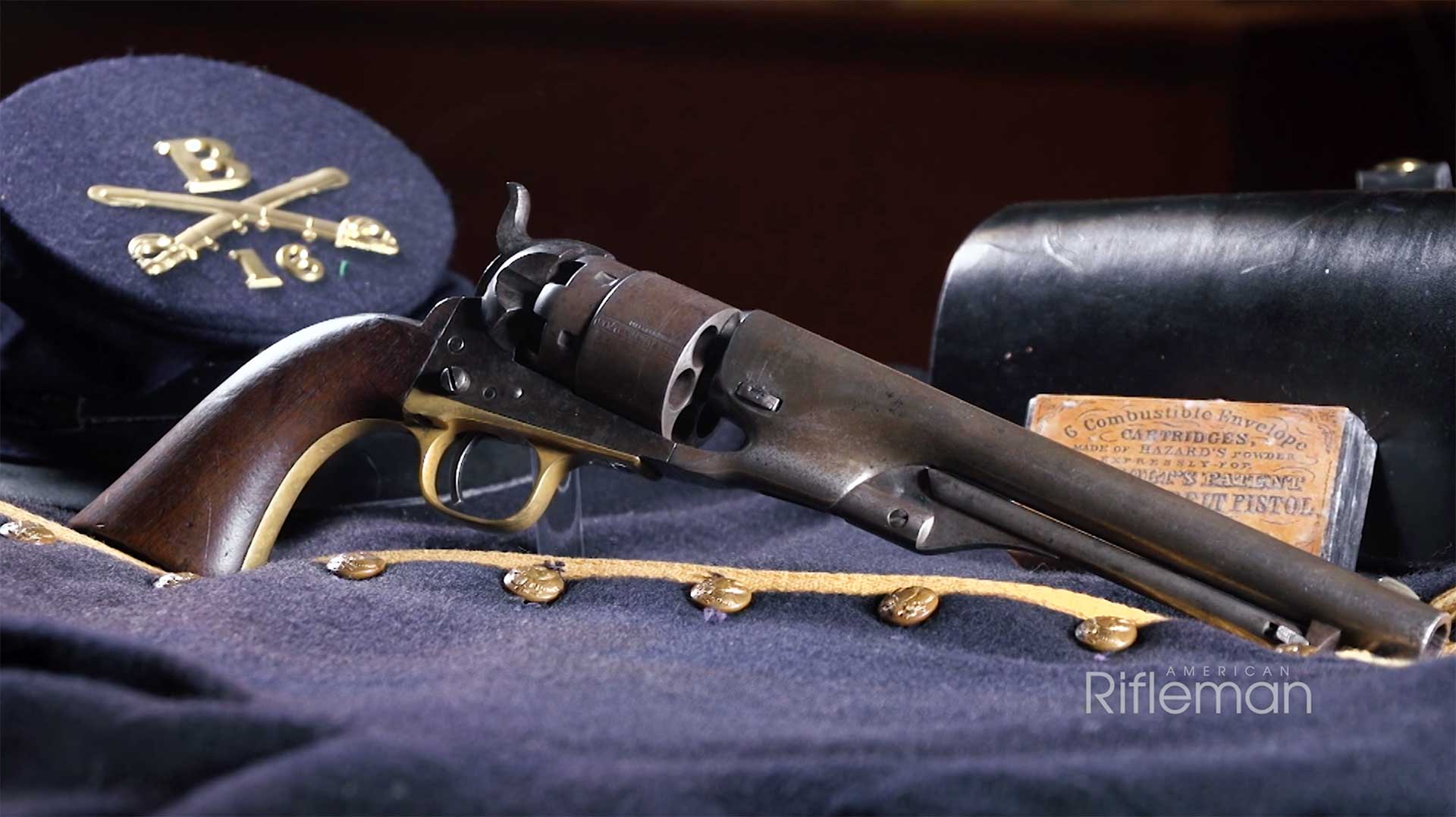
My old friend and a great sheep hunter, Jack Atcheson, Jr., once commented that “optics cost nothing and weigh nothing.” What he meant, of course, is that the role of optics is so important that neither how much you pay for them nor how heavy they are to pack should be significant factors in your choices. I’m not sure I’d go quite that far—we all have budgets, and there are limits on how much stuff we can carry—but you get the idea. In the field or on the range, optics matter.
There are lots of sporting optics on the market today and many good brands, but there is always room for more good stuff. Still, it’s difficult for a company to bring something truly innovative to that market.
When it comes to the name SIG Sauer, you would expect that anything bearing it would be of good quality. That is a nutshell description of the company’s new optics line called, in total, Electro-Optics. In such a well-populated market it would be unreasonable to expect reinvention of the wheel, and SIG has not done that. Many of its new optics are simply good products, in keeping with SIG’s trusted brand, however, the company has also managed to come up with some interesting innovations.
Alpha To Zulu
SIG Sauer’s Electro-Optics enters the field as an ambitious product line, pretty much spanning the full gamut of shooting and sporting optics. I do not claim to have had my hands on all of the products, or even a large assortment, but Electro-Optics was so new when I got the first shipment that I doubt anyone else had, either. So I can really only tell you in detail about what I have used, and I can give you a quick run-through of the initial product line.
Interestingly, SIG has used the phonetic military alphabet (Alpha, Bravo, Charlie, etc.) to identify the product lines. At the time of writing, SIG is using nine (out of 26), with more planned in the future. In alphabetical order: Alpha is for scope mounts; Bravo is for battle sights; Kilo is for laser rangefinders; Oscar is for spotting scopes; Romeo is for reflex and red-dot sights; Tango is for tactical riflescopes; Whiskey is for hunting riflescopes; X-Ray is for pistol sights; and Zulu is for binoculars. Although a few blanks are left to fill, this is quite an array of products right out of the starting gate.
All Electro-Optics are finished in matte gray with the company’s Stealth ID industrial design treatment, including the company’s deflection armor trapezoidal surfacing, that serves to reduce metal glare and break up the optic’s outline. Obviously this effect is less pronounced in SIG’s riflescope lines. All Electro-Optics also carry an “Infinite Guarantee”—lifetime, unconditional and transferable. That is a good and comforting policy, but, just to be clear, electronic and tritium components carry a five-year warranty.
A Full Suite For Hunting
As of this writing, I’ve used only a small sampling of the products that make up the new SIG optics line—but I’ve used them pretty hard. So it isn’t correct for me to claim that I have familiarity with the “full suite” of Electro-Optics hunting products. Among those parts of the line that I have had little exposure to are the scope mounts, the iron sights for handguns, the tactical scopes, and the red-dot and reflex sights. While some of those are primarily “tactically” oriented, others have hunting applications, if somewhat specialized.
The line is now the optics sponsor for the “Petersen’s Hunting Adventures” television series that I’m involved in, so last fall I used Electro-Optics for about six weeks in fairly rugged field conditions. This included blistering heat in the tropics of southern Mexico; frigid air in northern Montana; and more temperate weather conditions while whitetail hunting at my place in Kansas. I was able to use a Kilo2000 rangefinder, an Oscar3 spotting scope, a Whiskey5 riflescope and a Zulu3 binocular. The numerals behind the military phonetics suggest, correctly, that there are multiple models and, in some cases, product lines, within the letter designators. With such a wide array of products, the combination of phonetic letters and numbers for models and lines will be confusing at first. This is true of many manufacturers’ model designations, but once you get the system down most Electro-Optics model designators have some logic behind them. Here’s what I can tell you about the products that I have used.

KILO2000 Laser Rangefinder
Younger shooters probably take the compact laser rangefinder for granted. Believe it or not, I hunted for decades without this wonderful tool. Back then we estimated range by eye, sometimes getting it right, and sometimes not. There was one advantage: The only way to actually be certain of shooting distances was to pace it off, which we rarely did, so, most of the time, we could exaggerate our shooting distances (and who would know?). Today, the compact, inexpensive laser rangefinder is an almost indispensable tool—and an essential element of any reasonably complete optics line.
In the Kilo (rangefinder) line, Electro-Optics enters the market with just one initial model, the Kilo2000 7X 25 mm. Just 4.2" long, 3" tall, and 1.3" deep, and weighing 7.5 ozs. with a CR2 battery, it is a very compact but extremely advanced and user-friendly rangefinder. It is unusual that there is just one model in the Kilo lineup, but it’s almost certainly the only rangefinder anyone really needs. In this case the “2000” designation doesn’t make complete sense, but consider it an average of ranging capabilities. Under ideal conditions and ranging on a very large reflective surface, the beam can bounce back from up to 3,400 yds., or 1,500 yds. on trees and up to 1,200 yds. on deer-size game.
I think we all know that the perfect conditions that allow for maximum use rarely exist, but this is a very capable little rangefinder. One of the issues with long-range readings is holding the device steady enough to get a proper reading, especially on smaller objects. Kilo2000 can help with a “scan” mode, a dual-feature mode that yields four updates per second (“HyperScan”), while “RangeLock” yields the last or best reading.
Kilo2000 delivers readings in tenths of yards or meters, depending on mode, with yards as default. It is also one of relatively few rangefinders that figure those pesky uphill/downhill angles. There are two modes: Line Of Sight (LOS), which is the actual or “slant-range” distance; and Angle Modified Range (AMR), which is the distance corrected to horizontal range (parallel to the Earth’s surface). The AMR setting is the default, which most shooters will want. For extreme-range shooting, the LOS setting can be toggled back and forth to give the angle in degrees, allowing use of a computer application to yield the correction.
Operation is simple, with only “Mode” and “Ranging” buttons. The ocular lens has a diopter adjustment, and the display brightness is automatically adjusted to ambient light conditions. In the field, I found the Kilo2000 easy to use at both close and long range, in thick cover as well as open country, and while I never had the opportunity to get 3,400-yd. readings, it read quickly and accurately across a wide range of conditions and distances.

Oscar3 Mini Spotting Scope
Initially, there are two products within the Oscar (spotting scope) line: The Oscar5 “traditional” spotting scope in 15-45X 65 mm configuration, and the Oscar3 “mini”-spotting scope, available in 6-12X 25 mm and 10-20X 30 mm. It’s the latter mini-scope that I’ve been using, and it’s really useful. There are so many situations where you might need a spotting scope to check out antlers or horns—but do you really want to carry the darned thing? And if you carry a spotting scope, then you might as well carry a tripod so you can effectively use the scope, right?
The Oscar3 10-20X does not take the place of a full-size, high-magnification, tripod-mounted spotting scope. However, at a weight of just 16 ozs. and a length of 6.7" it does a very good job in those in-between situations where standard-size binoculars aren’t enough to count antler points, but you really don’t need the weight or bulk of a big scope and tripod. Also, Oscar3 can be utilized much more quickly, because you don’t need a tripod. The big secret is that the Oscar3 is gyroscopically stabilized: Mash the “on” button and the image stays still.
Mind you, there are limits, and I found them. If you’re huffing and puffing after climbing a hill, you cannot expect the internal stabilization of the Oscar3 to overcome your own internal destabilization. But if you take a few breaths, turn the device on and assume a steady, rested position, the clarity is wonderful. In open-country deer hunting, I often don’t carry a spotting scope because of the weight. When sheep hunting I have to, simply because it’s an essential tool and, after all, “optics cost nothing and weigh nothing” (until you reach a certain age, and then every ounce counts!). Oscar3 fills the gap. At 1 lb., its weight is minimal so it’s there when you need it. Hunting in the big coulees of northern Montana, I needed it often to interpret distant bucks from “worth getting closer to” or “pass.”
On the Oscar3 10-20X 30 mm, the focus is on the ocular lens, and I found it best to turn the stabilization to “on” (on the top housing), then start at 10X and zoom in slowly. I mentioned that Electro-Optics has come up with some interesting innovations, and this is certainly one of them. As a new tool, it takes some getting used to, but it is effective and user-friendly. Still, few of us are accustomed to dealing with 20X magnification in a hand-held mode, so it takes some practice to get the most out of it.

Whiskey5 Riflescope
Electro-Optics includes two separate lines of riflescopes, Tango (tactical) and Whiskey (hunting), all with 1"-diameter tubes. Obviously there is crossover between hunting and tactical, with the most obvious difference being that the tactical scopes are standard with external adjustment turrets; the hunting scopes are standard with covered adjustment turrets. However, on all Whiskey riflescopes the elevation turret can be replaced with a SIG Ballistic Turret (SBT) calibrated to your load. There are two lines of scopes within both Tango and Whiskey, and in this case the number following the phonetic letter is significant. The tactical line is Tango4 and Tango6; the hunting line is Whiskey3 and Whiskey5. The number indicates the zoom capability, so in the hunting line Whiskey3 is a traditional and more basic “three times zoom” variable. There are five Whiskey3 scopes ranging from 2-7X 32 mm to 4-12X 50 mm.
At the top of the hunting lineup is the Whiskey5, featuring five times zoom. There are six Whiskey5 scopes ranging from 1-5X 20 mm to 5-25X 52 mm, thus pretty much covering all sporting uses. All Whiskey5 scopes come with the Hellfire fiber-optic illuminated reticle, battery terminal and brightness-adjustment turret on the left side. All Whiskey5 scopes also qualify for a free SIG Ballistic Turret (SBT) calibrated to your load; after acquiring a scope you need to get the data of your load to SIG and it will send your dial-up turret.
The specific Whiskey5 scope I’ve been using is the 3-15X 44 mm. This is a useful and versatile power range, able to handle the vast majority of all hunting situations. It is a good scope, with clear optics and consistent quarter-minute adjustments. The signature matte gray finish is a bit unusual, but to my eye looks good on blued, stainless and black rifles. The power adjustment ring, just forward of the ocular lens, is heavily ribbed, and I found it extremely fast and easy to use. I have now mounted this scope on three different rifles, and all have produced groups as good as the rifles were known to produce. As far as ruggedness, well, the Electro-Optic scope passed my “hammer test.” More about that later.
So far we’re talking about sound scope design, but I promised innovation, didn’t I? I have become a believer in illuminated reticles—the eye is instantly drawn to the center in all light conditions—and I find them especially valuable in low light. Also, they are the cat’s pajamas on dark animals in dark shadows, whether bears, boars or buffalo. SIG’s Hellfire fiber-optic reticle allows a very precise illumination dot with no visible “bloom.” All good, but not notably different from other systems. Here’s the innovation: The turret has white squares in ascending size for setting the brightness of the dot (less in low light; more in bright light). In between each square is an “off” position, so you can select the dot appropriate for specific conditions then turn it off with only one click until its needed, which I found to be a clever feature.
There is one design characteristic requiring comment. A 3-15X 44 mm scope is neither small nor light, which is normal. The 44 mm designation indicates the size of the objective lens, which varies from 20 mm to 56 mm within the Whiskey5 line. This refers to the glass; in the 44 mm scope the actual objective bell is about 2" in diameter. Generally, this measurement dictates the height of scope rings you must use. The Whiskey5 scopes, however, share a common ocular bell that is also very substantial. I measured the diameter at 1.75", which is right at 44 mm. What this means is that, with some bolt-actions, even if the objective bell clears the barrel, you may need to go to higher mounts so that the ocular bell clears the action.
Remember my “hammer test” mentioned above? I started with the 3-15X 44 mm on a CZ 570 with low mounts. Perfect on the range, but in the field, as I adjusted the magnification ring, the ribbing on the magnification ring was catching the bolt handle in some of the power settings. This was intermittent and subtle enough that it took a while to figure it out. In the meantime, in the field, I literally had to pound on the bolt to get the rifle in and out of battery. It is a tribute to both rifle and scope that zero never changed. A higher set of rings cured the problem instantly, so this is neither bad nor good, just something to be aware of.

ZULU3 Binocular
Electro-Optics enters the field with four distinct binocular lines and a total of nine models. Essentially, in ascending order, Zulu3, Zulu5, Zulu7 and Zulu9 are roof-prism (straight tube) designs. Zulu3 offers 8X 32 mm and 10X 32 mm. Zulu5, in 8X 42 mm and 10X 42 mm, starts the HD lines. Zulu7, upgraded to HDX, is 8X 42 mm, 10X 42 mm and 15X 56 mm. Top of the line, also HDX, is Zulu9 in 9X 45 mm and 11X 45 mm. “Boddington’s Law of Optics” is that, in such a competitive market, you tend to get what you pay for. So, since price ascends through the lines, you could expect that optical quality and coatings also improve.
Since optics cost nothing and weigh nothing, why not start at the top? Well, aside from budget realities, there is no reason to either pay for or carry more glass than you really need. The binocular I have been using is the company’s most basic Zulu3 in 10X 32 mm. It is an open-hinge design that is easy to hold, and the clarity and resolution were just fine. Yes, for all-day glassing in sheep country higher-grade HD glass would be desirable, and as the light fades a larger objective (with equal or better glass) would gather more light. Even so, glassing under a wide variety of conditions I was extremely satisfied with the Zulu3, and I really enjoyed carrying it. The Zulu3 8X 32 mm is the lightest of the Electro-Optic binocular line, weighing just 14 ozs. The 10X 32 mm I carried weighs 16 ozs. In the context of such light binoculars, performance was outstanding.
So that’s a brief snapshot of Electro-Optics’ extensive line. For a more complete picture, contact SIG Sauer Electro–Optics, 72 Pease Blvd., Newington, NH 03801; (603) 610-3000; sigoptics.com.





































